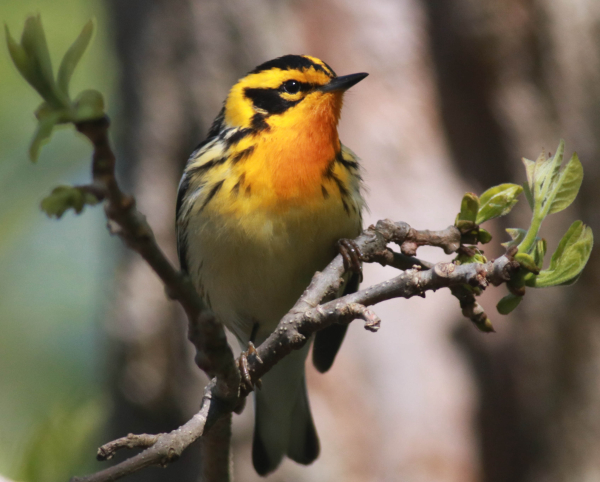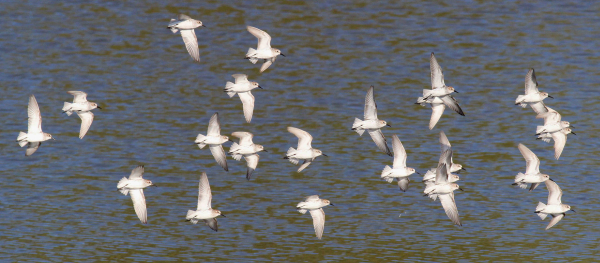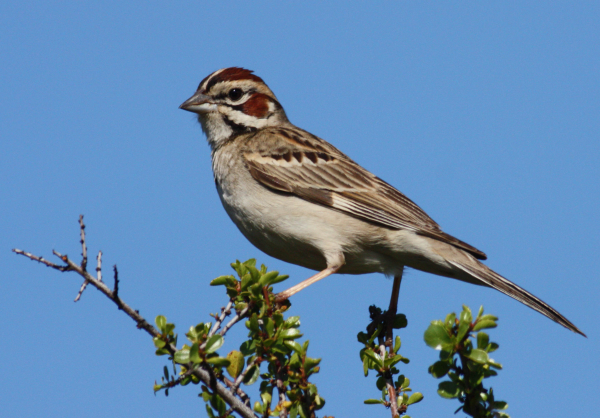
Our varieties of neotropical migrant songbirds, represented by this beautiful Blackburnian Warbler, need the focused and united support of birders and anyone interested in birds and nature to ensure we can end bird population declines so they can begin to rebound in numbers.

Shorebirds like Western Sandpipers rely on shallow wetland habitats with adjacent shorelines and upland habitats (photos by Paul Konrad).

Grassland species, including a variety of native sparrows such as this distinctive Lark Sparrow, have been especially affected by habitat conversion.
|
“This is an actual alert. I repeat, THIS IS AN ACTUAL ALERT! I refer to the unprecedented, grim statistics on bird population declines recently published in the prestigious journal Science by a consortium of biologists,” wrote John Fitzpatrick, the Executive Director of the Cornell Lab of Ornithology and originally published at the internet link listed below, who emphasized that birders have “truly enormous potential for influencing human attitudes and behavior” to reverse the trends that have reduced our nation’s wild bird populations by almost one-third since 1970.
Dr. Fitzpatrick continued: Detailed surveys of outdoor recreational habits across the United States routinely estimate that there are more than 50 million of us who regularly observe wild birds, and who cherish the many values birds provide. Moreover, these surveys also show that we represent every socioeconomic class and every political persuasion. This means that our collective voices constitute a potentially powerful force for change, and it is high time for us to raise our voices in support of all the steps required to halt and eventually reverse the steady reduction of North America’s bird populations.
Like many others, I go on occasional group birding tours, and sometimes attend birding festivals. I enjoy the outdoors with many friends who are casually familiar with birds but who appreciate learning more about them. Every winter I provide chili for our annual potluck “countdown dinner” to compile Christmas Bird Count sightings. In all such settings, we often talk with one another about how bird numbers seem to be dropping, and about all the problems they face (windows, cats, systemic pesticides, coastal development, horizon-to-horizon agriculture, etc.). The problem is that all this talk among ourselves – all this mutual preaching within our own choir – accomplishes only marginal good, if any at all. We already understand.
It is time for us to unite, to lift our collective voices, and to direct them outward to all the social, industrial, and political worlds that surround us, because now we actually know how bad the problem has become. We have lost almost a third of our nation’s wild birds since 1970! The scale of this loss is comparable to the extinction of the Passenger Pigeon, once the most abundant bird in the world, and the trend is continuing.
Never has it been more urgent for all of us who value wild birds and the habitats they represent to become an organized movement demanding social change. Birds convey vital messages about environmental health, and they play profoundly important roles for human wellbeing. We must begin speaking out, individually and together, in every possible forum, before it is too late.
Do we really have the numbers to effect social changes? To put the size of our grand group in perspective with several other socially influential groups, in 2018 our numbers in the United States alone exceeded those of registered Democrats (44 million), registered Republicans (33 million), gun-owning households (about 35 million), and AARP members (38 million).
Do we have specific causes that we should be communicating (and voting) about? Absolutely! The decline of our North American wild bird populations is a classic example of “death by a thousand cuts” and we need to become vocal about all of them. The litany is lengthy, but let me illustrate with a few starting points:
* 1) Stop tolerating unleashed outdoor housecats
* 2) Outlaw and eradicate feral cat colonies;
* 3) Advocate for and install bird-friendly window glass
* 4) Reduce big city lights during migration
* 5) Limit and regulate systemic pesticides such as neonicotinoids
* 6) Expand conservation zoning to reduce suburban sprawl
* 7) Expand protections for wetlands, especially along our coasts and at interior migratory stopovers
* 8) Convince large-scale agriculture to bring hedgerows back to our rural landscapes
* 9) Buy shade-grown coffee
* 10) Ban all recreational uses of lead
* 11) Fully fund the Land and Water Conservation Fund every year
* 12) Pass and sign the Recovering America’s Wildlife Act in this Congress
We must stop preaching among ourselves and use organized communication to lawmakers to harness the immense powers of the ballot box. While politicians vary widely in their levels of environmental knowledge and interest, they all share one thing in common: They turn their heads and listen if choruses grow loud enough in unison. Whether our commonest birds keep getting rarer year after year is going to depend on how well we can organize our voices, and how spirited we can be in delivering our message that the trend needs to stop.
For more details on a starter list of actions you can take at home, please see the “Seven Simple Actions to Help Birds” produced by the Cornell Lab of Ornithology, which is provided in this issue of The Birding Wire in the Backyard Birding article.
Dr. John Fitzpatrick’s article provides an important and spirited voice for all birders to rally around and address concerns and problems facing our wild birds locally, statewide, nationally, and internationally. His article was originally published in https://www.allaboutbirds.org/birding-choir-force-for-change/
To refer to the scientific publication in Science regarding the dramatic decline in bird populations, see https://science.sciencemag.org/content/366/6461/120